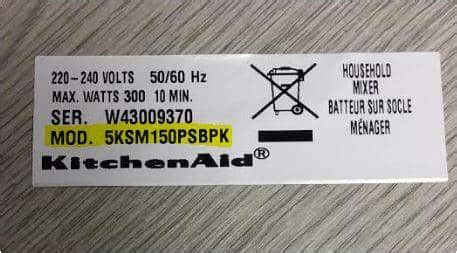
Kitchenaid, as a brand, is known for high-quality kitchen appliances ranging from stand mixers to refrigerators. Each model has distinct specifications and components that are unique to its design. Therefore, knowing the model number makes it easier to access accurate information, order replacement parts, or get the right guidance for maintenance and repairs.
A model number is a unique identifier assigned by the manufacturer to each product they produce. This number differentiates a particular model from others in the same product line. For Kitchenaid appliances, the model number provides details about the product’s color, style, and specific features.

Generally, the model number of a Kitchenaid stand mixer is found on the base or the back of the unit. It’s usually on a sticker or an embossed metal plate.
For these types of appliances, you’ll likely find the model number on the bottom. It’s often printed on a sticker or engraved into the plastic or metal.
Kitchenaid ovens, ranges, and cooktops typically have their model number on a sticker or plate located on the frame. This is often inside the oven door, on the door jamb, or on the edge of the cooktop.
For a Kitchenaid refrigerator, the model number is usually inside the refrigerator compartment. It’s often on a sticker or plate on the side wall or ceiling.
Kitchenaid dishwashers typically have their model number on a sticker or plate on the side of the door or the door jamb.
These locations are common, but not exhaustive. If you can’t find the model number in these places, refer to the user manual or the manufacturer’s website.

Kitchenaid model numbers usually consist of a combination of letters and numbers, and occasionally, a dash or a space. The first few characters often represent the product type. For instance, ‘KDTM’ might signify a Kitchenaid Dishwasher Top Control model.
The next series of numbers typically indicates the product’s unique features, such as the number of cycles in a dishwasher or the capacity of a refrigerator. The last few characters often represent the color code.
While this breakdown gives you a general idea, it’s not universally applicable to every Kitchenaid model number. The exact structure can vary based on the product type and the year it was manufactured.

1. What if I cannot find the model number on my Kitchenaid appliance?
If you’re having difficulty finding your model number, you can refer to the user manual or contact Kitchenaid’s customer service for assistance. Keep in mind that the model number is not the same as the serial number, which is also found on your appliance.
2. Why is the model number important when ordering parts or scheduling repairs?
The model number ensures you get the correct parts and service for your specific Kitchenaid appliance. Each model has unique components, so using the wrong parts can lead to further damage or decreased performance.
3. Can I use a model number to determine the age of my Kitchenaid appliance?
Generally, the model number itself doesn’t indicate the manufacture date. However, the serial number, usually found near the model number, often contains this information.
Knowing how to locate the model number on your Kitchenaid appliance is essential for effective operation and maintenance. This unique identifier empowers you with the correct information, ensuring you get the right parts, accurate repair instructions, and access to specific features and specifications. So next time you need to look up something about your Kitchenaid appliance, take a moment to locate the model number. It’s the key to unlocking a wealth of information about your device.
